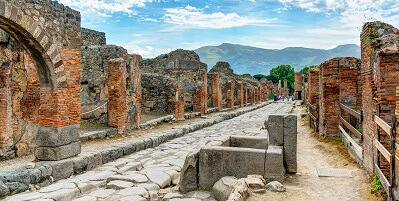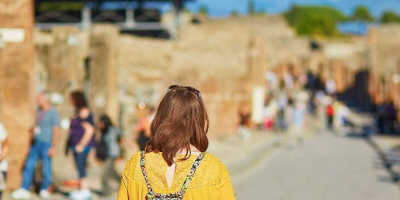Can you walk around Herculaneum?
You may not have heard of the ancient Roman citadel of Herculaneum, probably because its nearby neighbour Pompeii steals all the volcanic thunder, but you will be thrilled to know that it is another incredible town preserved by the mighty ash of Mount Vesuvius in 79 AD!
And what makes it just as remarkable as Pompeii is the fact that you walk around all of its ruins in just a few short hours, taking in all the incredible aspects of daily life in this smaller Roman town from just before its cruelly destroyed by that great eruption.
So, what exactly is Herculaneum known for? And why should it be on your list of things to do before or after you head to the much-more-famous Pompeii?
Let’s find out below…
The Hall of Augustus
Okay, so, pretty much every Roman town had its own grand structures in testament to its Gods and Emperors, right? And Herculaneum is absolutely no exception!
One of such amazingly impressive buildings is the Hall of Augustus – the seat of free men who were dedicated to the Emperor Augustus. This giant structure consists of a square-like design replete with stunning frescoes, grand columns, cocciopesto floors, completing a delightful building to rival any of those found over at Pompeii.
The Baths
Like other Roman baths, Herculaneum’s addition was divided into baths for men and women. Here, you can meander around these impressive recreational centres, taking in the changing rooms and bathing rooms that, despite their ornate design that was also buried by ash and pumice, aren’t too dissimilar from the recreation centres you would find today – even the change rooms have little dugouts for storing clothes!
The Fornici
The Fornici were the port warehouses that today serve as one of the more macabre sites in Herculaneum or even Pompeii. Why? Because plenty of skeletal remains here were unearthed when Herculaneum was excavated (before Pompeii, mind you) and serve as a harrowing reminder of the grim, apocalyptic nature of that day.
The House of the Wooden Partition
Despite the grim nature of Herculaneum, there are moments around town that remind you of the ability to survive such natural disasters. One such reminder is The House of the Wooden Partition, named as such for the structure that managed to survive the eruption and still stands in top quality condition today!















